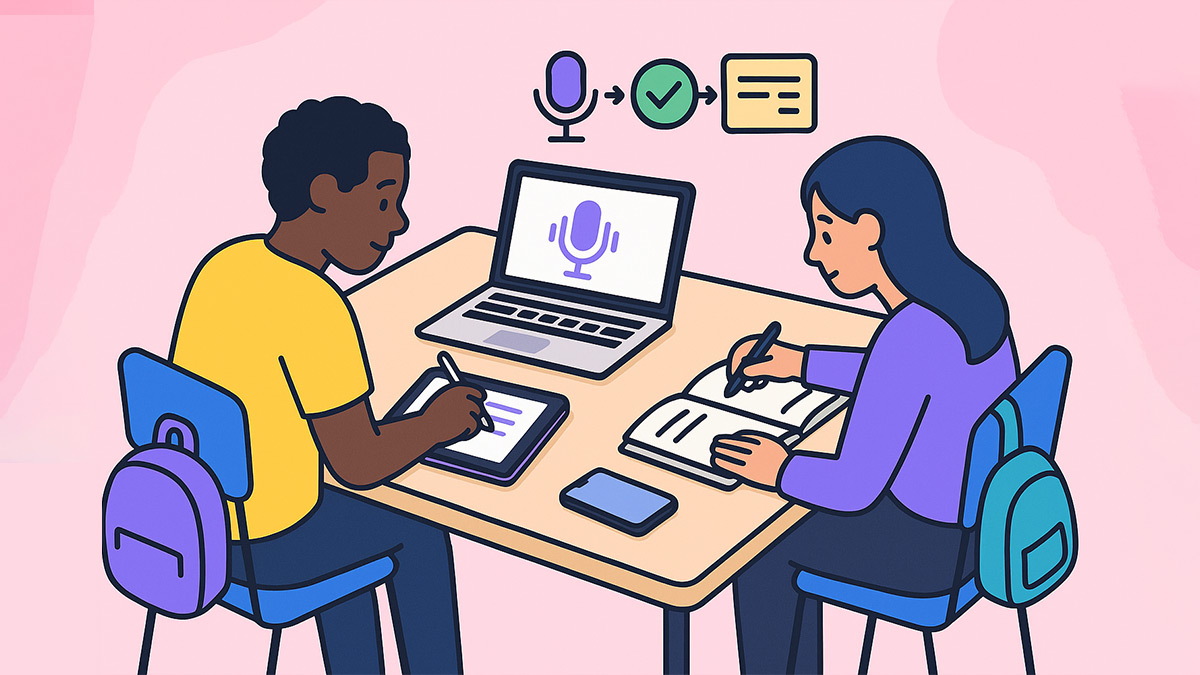Chatgpt study workflows turn messy lectures into structured notes, study guides, and practice. In this guide you get 25 proven workflows, fast prompts, and export tips to learn faster and retain more. Trusted bodies such as UNESCO and EDUCAUSE publish guidance on responsible AI use and classroom impact.
What You’ll Learn
- How to turn lecture audio or captions into clean notes and a one-pager.
- Prompts for quizzes, flashcards, and retrieval practice that raise recall.
- Fast templates for diagrams, definitions, examples, and comparisons.
- Export and review routines that fit weekly study schedules.
- Ethical and privacy guardrails when using AI for coursework.
Quick Start
- Collect input: audio file, Zoom/YouTube captions, or slides/PDF.
- Upload to ChatGPT.
- Run the “One-Pager + Headings” prompt to structure the lecture.
- Generate 10 recall questions and 15 flashcards from the same notes.
- Ask for a weekly review plan with spaced retrieval.
- Export to Google Docs or Markdown for class sharing.
Top 25 ChatGPT Study Workflows for 2025
Copy any prompt, paste your topic and inputs, then run. Link back to your AI study guide generator for rapid one-pagers.
25 ChatGPT Study Workflows (copy-ready prompts)
- One-Pager from Lecture: “You are a study coach. From this transcript, produce a one-page summary with H2 sections: Overview, Key Concepts, Definitions, Examples, Common Pitfalls, and 5 takeaways. Keep under 350 words. Transcript: <paste>.”
- Cornell Notes Maker: “Convert this lecture into Cornell notes with Cues, Notes, and Summary. Include timestamps where possible. Input: <paste>.”
- Key Terms + Definitions: “Extract the top 20 terms from this lecture. Give concise, exam-ready definitions and one simple example each. Input: <paste>.”
- Compare/Contrast Table: “Build a table comparing <concept A> vs <concept B> with columns: Definition, Formula/Rule, When to Use, Strengths, Weaknesses, Example.”
- Worked Example Builder: “Create 3 worked examples from this topic. Show steps, reasoning, and final check. Topic: <paste>.”
- Practice Quiz (Retrieval): “Generate a 10-question mixed quiz (MCQ + short answer) from these notes. With answer key and one-line rationale. Notes: <paste>.”
- Flashcards (Active Recall): “Make 25 concise flashcards in Q → A format. Keep answers ≤25 words. Source: <paste>.”
- ELI5 then Level-Up: “Explain <topic> to a 12-year-old. Then explain to a first-year college student. Then give one advanced insight. Keep each under 120 words.”
- Socratic Tutor: “Ask me 8 probing questions about <topic>. Wait for my answer each time. If I’m wrong, give a hint before revealing the solution.”
- Error Log: “From this practice set, find my mistakes, name the misconception, and show the minimal fix. My answers: <paste>.”
- Equation Sheet: “Produce a formula sheet with variable meanings, units, and one example per formula. Topic: <paste>.”
- Timeline + Cause/Effect: “Create a timeline of <event/topic> with causes, effects, and 3 primary sources to read next.”
- Definitions in Your Words: “Rewrite these definitions in my voice with simple language and a memory hook. List: <paste terms>.”
- Concept Map Outline: “Give an outline for a concept map linking <A>, <B>, <C>, with 2–3 labeled edges each and a short caption per edge.”
- Worked Proof or Derivation: “Show a clean derivation of <theorem/formula> with the minimal assumptions and a boxed result.”
- Case Study Deconstruction: “Break this case into Situation, Stakeholders, Options, Criteria, Trade-offs, and Recommendation. Case: <paste>.”
- Lab Report Helper: “Draft a results + discussion section from this data, add one graph idea, and list 2 threats to validity. Data: <paste>.”
- Source Triangulation: “Summarize 3 credible sources on <topic> with citation, agreement/disagreement, and one open question. Give links if public.”
- Explain by Analogy: “Explain <topic> using an everyday analogy, then show where the analogy breaks.”
- Common Pitfalls List: “List the 10 most common mistakes learners make on <topic> and how to avoid each in one line.”
- Study Plan, 2 Weeks: “Create a 14-day plan for <course/topic> with 30–60 min per day, mixing reading, practice, retrieval, and rest days.”
- Spaced Retrieval Schedule: “From these flashcards, schedule 4 reviews over 10 days using expanding intervals. Output a calendar table. Cards: <paste>.”
- Open-Ended Concept Checks: “Ask me 8 short prompts that require explaining ideas in my own words. Wait for each answer before scoring 0–2.”
- Past Paper Alignment: “Map these notes to <exam spec or past paper> topics. Flag gaps and propose 5 targeted drills.”
- Ethical Use Checklist: “Create a checklist to use AI responsibly for this assignment. Include citation, originality, privacy, and instructor policy checks.”
Troubleshooting & Tips
- Privacy first: remove names, grades, and IDs from uploads.
- Keep one source of truth. Sync exports to a single Google Doc.
- Use retrieval often. Short quizzes beat re-reading for retention. See evidence.
- Control scope. One lecture per run yields cleaner outputs.
- Review bias. Cross-check facts with your textbook or slides.
- Accessibility. Request alt-text for images and captions for videos.
- Instructor policy. Confirm allowed AI use before submitting work.
FAQ
Is typing or handwriting better for notes when I use AI?
Under controlled conditions, method does not predict performance. Focus on clarity, review, and retrieval practice. Source below.
Can I rely on AI for factual accuracy?
No. Treat AI as a drafting and tutoring aid. Verify with course materials and cite sources when required.
What is the fastest workflow from lecture to study guide?
Transcribe or paste captions → one-pager prompt → quiz and flashcards → export. Use our lecture-to-notes tool to standardize steps.
How often should I review?
Use spaced retrieval. Example: Day 0, Day 2, Day 5, Day 10. Keep sessions short and focused on weak areas.
Is AI allowed for assignments?
Policies vary by course and campus. Follow your instructor’s guidance and institutional AI policy. UNESCO and EDUCAUSE offer principles for responsible use.
Is typing or handwriting better for notes when I use AI?
Under controlled conditions, note-taking method shows no reliable performance difference. Prioritize structure, review, and retrieval practice.
Can I rely on AI for factual accuracy?
No. Use AI to draft and tutor, then verify with your textbook, slides, and primary sources.
What is the fastest lecture-to-guide workflow?
Transcribe captions → generate one-pager → quiz + flashcards → export. Automate with the Lecture to Notes tool.
How often should I review?
Adopt spaced retrieval across 4 sessions over ~10 days, focusing on weak items.
Is AI allowed for assignments?
Check your syllabus and campus policy. Cite clearly and protect privacy.
Wrap-Up
Use these workflows to turn raw lectures into structured notes, quizzes, and flashcards. Anchor your routine in retrieval practice. Start with our AI study guide generator, and see how to start AI note-taking. If you are new here, visit the PolarNotes homepage.
References:
Voyer et al., 2022;
Bego et al., 2024;
UNESCO, 2023;
EDUCAUSE, 2023



